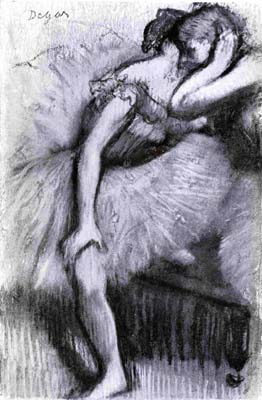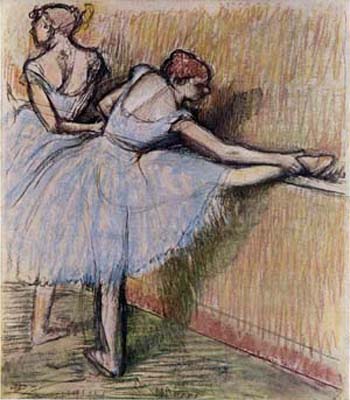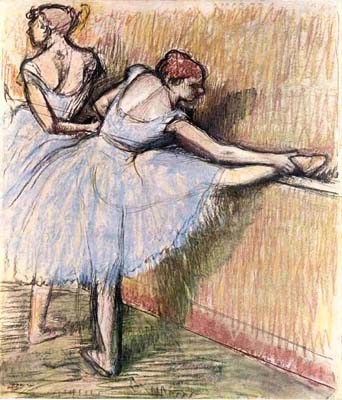
Bulletin 3 (II:1), 1964
Home
Français
Introduction
History
Annual Index
Author &
Subject
Credits
Contact



Danseuses à la barre by Degas
by Jean Sutherland Boggs,
author, curator, The Art Gallery of Toronto
Pages 1 | 2
| 3
If we turn to the group of works around Ottawa's pastel, we
find a preparatory drawing of the figure at the left (Fig. 5) which
is almost the reverse of the drawing of the figure at the right in
the other com- position (Fig. 4) .The differences between the two
help us date the Ottawa work, if only by making it improbable that
it should be, like the other drawings, from c. 1885. If we were
comparing the originals rather than their illustrations we should be
struck by a difference in scale - the drawing of the one ballerina,
which can safely be described as later, three times as high and
three times as wide as the drawing from about 1885. The next
conspicuous difference might be that the later dancer is an adult
with a certain automatic professional control over her body - and in
her very adulthood and skill a generalization without the specific
personality of the adolescent girl. In her body there is not the
same sculptural force into space, combined with physical strength,
that one sees in the shoulders and the arm of the little dancer;
indeed, as the preliminary study of her nude (Fig. 6) makes
particularly clear, the contours of her body are heavy and almost
monotonously similar, without the variations and breaking which give
such animated direction to the earlier work. She seems, partly
because of the limitations of the strong contour, to have been
conceived in a flatter, more confined space than the other dancer,
and altogether more compressed around the vertical of her body.
Finally, instead of the free and open charcoal strokes which suggest
light and shadow in the earlier drawing (particularly
illusionistically upon the tutu), these strokes are more
severely parallel, and closer to each other, creating an effect of
artificial luminosity rather than of the sun.
This figure, in Ottawa's pastel (Fig. 9), is almost concealed by an
ungainly dancer who struggles to put her foot on the bar - a figure
worlds removed from the ease of the ballerina in Fig. 1. She is
angular, harshly described) apparently unbalanced both physically
and psychologically as she concentrates upon the barre. We
are far from the charm and wit of the composition from the
mid-eighties. The work does have a beauty in its light, its colour
and the strength of the movements through the contour lines - but
this beauty seems independent of the cruel description of the
dancers.
To return to our original question, in asking, "Where does this
drawing fit into Degas' career?", we can at least eliminate any
probability that these later works should be close enough to those
of the mid-eighties to be from the dates M. Lemoisne suggests -
1884-88.
In the works Degas dated there is nothing helpful between 1886 and a
small group from 1894 and 1895. One of the pastels from 1894 - a Racetrack (23)
- is instructive because it is almost a replica of another of
the same subject which Degas dated in 1884. (24) The later work is
more generalized, less brilliant in its contrasts in colour, less
specific in its description of space, and moodily dominated by a
dark shadow on a hill in the background - and in these respects
closer to Ottawa 's drawing. A nude (25) and a figure dressing, (26)
which are also dated 1894, seem anatomically similar to the drawing
of the dancer nude, And in the opaque oil and the bold colour of the
painting in the Phillips Collection, there is a suggestion of the
handling of both in the painting of Henri Rouart and his son
Alexis (27) which can be dated by two preparatory drawings (28) which
are inscribed "1895." Our group seems more at home in this
period of Degas' career.
There are reasons, however, for shoving this group even further on
chronologically. One is that the mood is fiercer and less gently
bewildered than the works which are dated 1894 and 1895. Another is
that the handling of charcoal, pastel or paint does not have as many
spirited passages. The most conclusive argument against a date of
about 1894 or 1895 is provided by Degas' only late dated study of
the dance, the pastel called Danseuses: Rose et Vert from
1894. (29) These dancers are more fully described physically - the
arms and backs more strongly articulated, the calves of the legs
more muscular. Ottawa's other pastel of Danseuses (Fig. 7),
which Lemoisne dates 1891 (30) and Browse a related work c. 1890-1900,
(31) seems closer to it. The Danseuses à la Barre, when
compared with both these works, seems peopled by mere wraiths.
The works of Degas' late years do seem populated by ghosts - dancers
with frail, insubstantial bodies and fierce souls revealed by a
brilliant, warm and uncanny light. Their figures, like the drawing
of the nude (Fig. 6), seem to have been originally conceived as
possessing some flesh, a certain strength and an energy, to which
the dancer herself in this drawing seems characteristically
indifferent. In the only late dated drawing of a nude, a pastel from
1903, (32) there is perhaps an even greater suggestion of the absence
of a determining reason behind the marvelous but exaggerated
movements of the bather drying her leg. Movements, independent of a
controlling and conscious mind within the body, dominated his latest
works.
When Degas added the dress to the body of the dancer (Fig. 5) he
removed any of the figure's roundness, even in the contours of the
arm. The sculptural density of that body seems absorbed by the
intensity of the light. By the stage of the drawing in Ottawa (Fig.
9) that body seems to have little existence aside from the forceful
strokes of Degas' pastel: it is these alone which give the work its
vitality and its structural strength. By the finished oil (Fig. 8)
she is even further removed from the descriptive - her leg
elongated, her profile simplified, her back a rich play of colour
and light. And apathy has triumphed; the sense of a concerned mind
within the
dancer has disappeared.
This group of late works reveals Degas working towards the abstract,
taking the human body, describing it but gradually evolving a form
for it which is dominated by line and colour. In the pastels and the
oil, which involve both figures, the structure and the strength of
the works depend upon line, colour, light and the touch with which
Degas applied chalk or paint. But abstraction, although carried so
far, was not an end in itself; instead it was used to convey a
feeling of pathos in the contrast between the energy of the colour
and the line, and the ungainliness of the dancers struggling at the barre.
This same quality exists in two groups of portraits of members
of the Rouart family which can be dated 1904 and 1905. (33)
It would seem unsafe to try to date the National Gallery pastel any
more precisely than between 1895 and 1905 although Miss Browse is
probably correct in putting it into the twentieth century. In it we
can see how the confidence which the Impressionists felt in the
years in which they were exhibiting together (1874 to 1886) was
transformed into the disillusionment which was part of the fin de
siècle spirit.
Next Page | Notes
1 | 2
| 3
Annual Index | Author & Subject | Credits | Contact
This digital collection
was produced under contract to Canada's Digital Collections program,
Industry Canada.
"Digital
Collections Program, Copyright
© National Gallery of
Canada 2001"